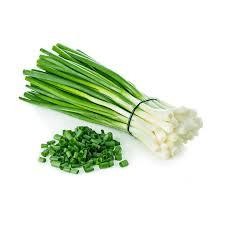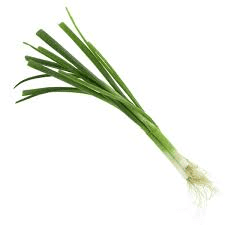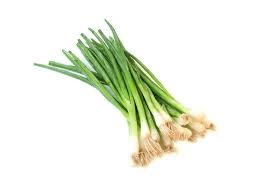Onion leaves are the green, elongated parts of the onion plant that extend from the bulb. These leaves are essential for the onion’s growth, development, and overall health.
Onion leaves consist of hollow, tubular structures that are often referred to as “shoots” or “stalks.” They emerge from the top of the bulb and grow upward. The primary function of these leaves is to carry out photosynthesis, the process by which the plant converts sunlight into energy.
The green color of the leaves is due to the presence of chlorophyll, which absorbs light and helps the plant produce carbohydrates necessary for its growth.
The structure of onion leaves is adapted to maximize their role in photosynthesis. The tubular shape of the leaves allows them to capture sunlight more efficiently, while their hollow nature provides a lightweight and flexible structure. The leaves also have a waxy coating that helps reduce water loss through evaporation, ensuring the plant retains moisture.
In addition to photosynthesis, onion leaves play a role in the plant’s nutrient and water transport system. They help in the distribution of essential nutrients and water absorbed by the roots to different parts of the plant, including the bulb. This ensures that the bulb receives the necessary resources for growth and storage.
Onion leaves also contribute to the plant’s overall health by providing a surface for gas exchange. Tiny openings called stomata, located on the surface of the leaves, allow for the exchange of gases such as oxygen and carbon dioxide. This process is crucial for photosynthesis and respiration, enabling the plant to produce energy and grow effectively.
During the onion’s life cycle, the leaves may undergo changes depending on environmental conditions. For instance, if the plant is stressed due to drought, the leaves might become yellow or wilted as the plant conserves water. Conversely, in optimal conditions with adequate water and nutrients, the leaves will be vibrant green and robust.
In culinary terms, onion leaves are edible and often used in cooking. They have a milder flavor compared to the bulb and can be used as a garnish or ingredient in salads, soups, and other dishes. The leaves add a fresh, crisp texture and a subtle onion flavor, enhancing the overall taste of various recipes.
In summary, onion leaves are crucial for the plant’s growth, energy production, and nutrient transport. They enable the plant to perform photosynthesis, distribute resources, and adapt to environmental changes. Understanding the role of onion leaves highlights their importance in both the life cycle of the plant and their culinary uses.
The Economic Importance and Uses of Onion Leaves

1. Culinary Uses: Onion leaves, also known as green onion tops or scallion greens, are used in cooking to add a mild, fresh onion flavor. They are commonly used in salads, soups, stir-fries, and as a garnish. For example, chopped onion leaves are often added to salads for a crisp texture and flavor.
2. Nutritional Value: Onion leaves are rich in vitamins A, C, and K, as well as antioxidants and dietary fiber. They contribute to a balanced diet and support overall health.
3. Health Benefits: The antioxidants and vitamins in onion leaves can help combat oxidative stress, support cardiovascular health, and boost the immune system. They may also aid in digestion and reduce inflammation.
4. Traditional Medicine: In some cultures, onion leaves are used in traditional medicine for their perceived health benefits, such as promoting digestive health and alleviating respiratory issues.
5. Fresh Produce Market: Onion leaves are a popular item in fresh produce markets and grocery stores. They are sold fresh and are a staple ingredient in many kitchens.
6. Hydroponic Farming: Onion leaves can be grown hydroponically, providing a sustainable and efficient way to produce fresh greens in urban and controlled environments.
7. Compost Material: Onion leaves can be added to compost piles, where they decompose and contribute organic matter and nutrients that enrich the compost mix.
8. Edible Garnishes: Onion leaves are used as a garnish in restaurants and home kitchens to enhance the presentation and flavor of various dishes.
9. Green Manure: Onion leaves can be used as green manure to enrich soil. They are incorporated into the soil to add organic matter and nutrients.
10. Sprout Production: Onion leaves can be grown as sprouts, which are used in salads, sandwiches, and as a garnish. They offer a quick and nutritious addition to meals.
11. Food Preservation: Onion leaves can be dried and preserved for later use in cooking. Dried leaves are used in seasonings and spice blends.
12. Organic Farming: Onion leaves are used in organic farming practices as they contribute to soil health and can be grown without synthetic pesticides.
13. Culinary Innovation: Chefs and food scientists experiment with onion leaves to create new culinary products and recipes, incorporating them into sauces, dressings, and specialty dishes.
14. Nutritional Supplements: Extracts from onion leaves are used in dietary supplements for their health benefits, such as supporting cardiovascular health and boosting immunity.
15. Natural Pest Repellent: Onion leaves can act as a natural pest repellent when planted alongside other crops, helping to deter certain garden pests.
16. Educational Purposes: Onion leaves are used in educational settings to teach students about plant growth and agriculture. They are often used in school gardens and science projects.
17. Microgreens: Onion leaves can be grown as microgreens, which are popular for their nutritional value and intense flavor. They are used in salads and as garnishes.
18. Urban Agriculture: Onion leaves are ideal for urban agriculture projects, including rooftop gardens and community farms, due to their ease of cultivation and minimal space requirements.
Read Also: 5 Medicinal Health Benefits of Liquidambar orientalis (Oriental Sweetgum)
The Products and By-products That Can Be Derived From Onion Leaves

1. Fresh Green Onion Leaves: Used directly in cooking and garnishing.
2. Dried Onion Leaves: Preserved for use in seasonings and spice blends.
3. Onion Sprouts: Grown for use in salads, sandwiches, and as garnishes.
4. Compost Material: Added to compost piles to improve soil fertility.
5. Green Manure: Incorporated into soil to add organic matter and nutrients.
6. Hydroponic Onion Leaves: Grown in hydroponic systems for fresh, sustainable production.
7. Nutritional Supplements: Extracts used in dietary supplements for health benefits.
8. Organic Farming Inputs: Used in organic farming to enhance soil health and productivity.
9. Microgreens: Grown as a nutritious and flavorful addition to meals.
10. Educational Tools: Used in schools for teaching about plant growth and agriculture.
11. Natural Pest Repellents: Planted to deter pests in gardens and agricultural fields.
12. Culinary Innovations: Incorporated into new culinary products and recipes.
13. Food Preservation: Dried leaves used in preserved food products.
14. Garnishes: Used as decorative elements in culinary presentations.
15. Fresh Produce: Sold fresh in markets and grocery stores.
16. Nutrient-rich Compost: Used to enrich compost for gardening and farming.
17. Urban Agriculture Products: Grown in urban settings for local consumption.
18. Green Smoothies: Added to smoothies for an extra nutritional boost.
Read Also: 25 Medicinal Health Benefits Of Astragalus amphioxys (Crescent milkvetch)
Frequently Asked Questions (FAQ’s) About Onion Leaves

1. What are onion leaves? Onion leaves are the green, leafy tops of the onion plant, also known as green onions or scallion greens.
2. How are onion leaves used in cooking? They are used in a variety of dishes, including salads, soups, and stir-fries, for their fresh flavor and texture.
3. What nutritional benefits do onion leaves provide? They are rich in vitamins A, C, and K, antioxidants, and dietary fiber, supporting overall health.
4. Can onion leaves be grown hydroponically? Yes, onion leaves can be grown hydroponically, making them suitable for urban and controlled environment agriculture.
5. How are onion leaves used in traditional medicine? They are used in traditional remedies to support digestive health and respiratory function.
6. Are onion leaves good for composting? Yes, they can be added to compost piles to enrich the compost mix with valuable nutrients.
7. What are microgreens, and how are onion leaves used in this form? Microgreens are young, edible plants harvested at an early stage. Onion leaves can be grown as microgreens for added nutrition and flavor.
8. Can onion leaves be used as natural pest repellents? Yes, they can help repel certain garden pests when planted alongside other crops.
9. How are onion leaves preserved for later use? They can be dried and stored for use in seasonings and spice blends.
10. What are the benefits of growing onion leaves in urban agriculture? They are ideal for urban agriculture due to their ease of cultivation and minimal space requirements.
Read Also: Top 11 healthiest fruits on Earth and there health benefits

